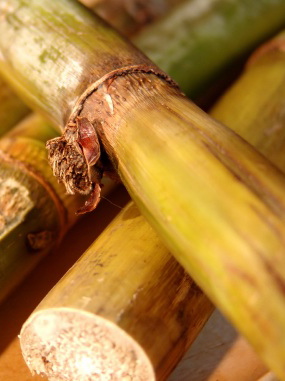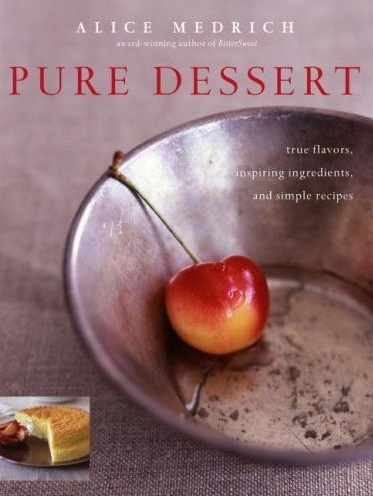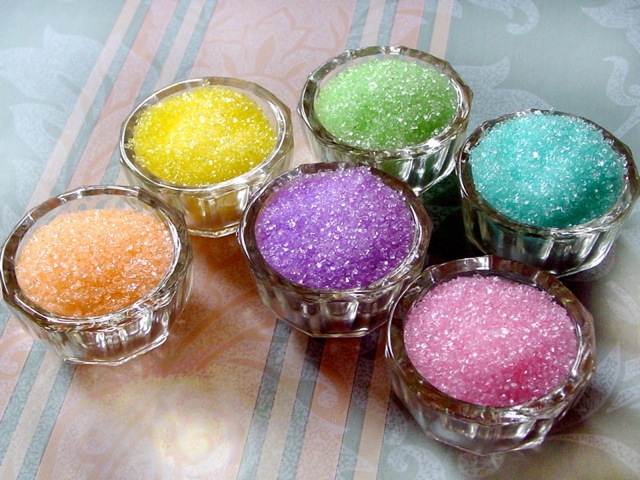
feature-image, l
(article, Nancy Schatz Alton)
[%pageBreakSettings maxWords=900] I’m standing in my local grocery store, staring at a rainbow of sweet flavors. Bright in its pink-and-white bag is that old standby, C&H Pure Cane Sugar. It’s priced a little higher than the store’s house brand, but is it really any different? Light glints off the clear plastic bags encasing a range of brown sugars, from light to dark. The Sucanat, an unrefined cane sugar, appears coarse and brown, but my nutritionist recommends it for its extra nutrients. There’s also the exotic-looking demerara, with its chunky brown crystals; my mother-in-law loves it for its rich flavor. Does the color brown connote a healthier choice? If the sugar is imported or organic, does it taste better? And how would my sugar cookies look and taste if I made them with a raw sugar instead of a refined white sugar? It doesn’t take much digging to learn that sugar is basically sugar, no matter what it’s called. Refined sugars are really just plain sucrose, with no vitamins, minerals, protein, fats, or fiber. As nutritionist Marion Nestle points out in her book What to Eat, sucrose is just one type of caloric sweetener, this time “composed of two single sugars (monosaccharides), one of them glucose (blood sugar) and the other fructose (fruit sugar).” Raw sugars, such as Sucanat or muscovado, contain minerals in addition to the sucrose; some varieties even contain iron, calcium, and vitamins. [%image feature-image float=right width=400 credit="Photo: iStockphoto/luminouslens" caption="Clockwise from top left: dark brown sugar, powdered sugar, light brown sugar, and refined white sugar."] “Because they still have some nutrients intact, \[raw sugars are\] not as shocking or stimulating to our system,” says Seattle-area nutritionist Ami Karnosh. “They tend to be better for our bodies.” Eat sugar alongside other nutrients, Karnosh recommends. “That’s not to say an oatmeal cookie will save you from a sugar rush, but it’s a healthier alternative to one without oatmeal,” she says. But, Karnosh adds, take a closer look at the various colors, textures, and flavors of sugar, because they matter in the kitchen. Refined white sugar, for example, lacks scent or strong flavor, but pastry chefs swear by its cooking properties. Raw sugar, on the other hand, always carries the aroma of the place it was grown; this complexity can make a dessert shine or add flavor to a cup of coffee. Sugars differ in both production and processing. Here’s a primer explaining most of the sugars on the shelf. Refined white sugar, also called standard granulated sugar and table sugar, is far removed from its original source. It’s usually made from sugar cane, a tall, grass-like stalk that resembles bamboo cane and grows in tropical and subtropical climates. Most commercially produced refined sugar comes from plantations in Latin America, East Asia, the Caribbean, and from large commercial cane operations in the United States. (Table sugar is also made from sugar beets, which are grown in more temperate areas of North America and Europe.) Sugar cane is usually crushed to extract its juices within 24 hours of harvesting. The resulting liquid is filtered to remove impurities, then heated to concentrate it and supersaturate the sugar content. This is when sugar crystals form. Then the sugar is spun in a turbine, separating out much (but not all) of the cane’s natural molasses. (Molasses is a syrupy by-product of processing sugar cane or sugar beets.) In organic milling, crystals are then packaged and sent to markets. In conventional production, the raw sugar is then shipped to a refinery in the U.S. “The raw crystals are liquefied, crystallized, bleached, and decolorized. Then the process is repeated again and again,” says Karen Stevenson, the marketing communications manager for Wholesome Sweeteners, a supplier and manufacturer of organic, natural, and fair-trade-certified sugars, syrups, and nectars based in Sugarland, Texas. “The refining process completely removes any remaining molasses from the sugar.” The cultivation of conventional sugar cane can be rough on the environment. In conventional sugar operations, cane is grown with the aid of numerous fertilizers, pesticides, herbicides, and defoliants. If defoliants aren’t used, the fields are burned to rid the cane of debris; the burning pollutes the air and destroys wildlife habitat. Next, harvesting machines slice the cane from the fields. (In Wholesome Sweeteners’ cane fields, however, the cane is hand-cut with machetes. The leaves are trimmed from the cane stalks and left to decompose naturally in the fields, restoring nutrients to the soil, reducing erosion, and preventing weed growth.) [%image cane float=left width=250 credit="Photo: iStockphoto/akaplummer" caption="Sugar cane is the source of cane sugar."] Working conditions in some sugar fields might leave you with a bad taste in your mouth. For example, the 2006 television documentary "Big Sugar" showed viewers the shantytowns occupied by Haitian sugar-cane workers working on the Central Romana plantation in the Dominican Republic. Earning $2 for 12 hours of work, the workers struggled to buy food at the company store and received little medical attention. According to Mark Ellam, the video journalist who visited the shantytowns, “What I saw was straight out of a book before the Industrial Revolution.” But there’s a bright side to modern sugar production: The byproducts of the sugar-cane plant can help create electricity. “When the cane is crushed, what is left over is a very fibrous, pulpy mix called bagasse. When it is dried, it makes a really effective fuel,” says Wholesome Sweeteners’ Stevenson. Wholesome Sweeteners uses bagasse to run its sugar turbines. And Florida Crystals’ renewable-energy power plant in western Palm Beach County, Florida, uses bagasse and urban wood waste to provide power for its Okeelanta facility’s milling and refinery operations as well as almost 60,000 homes. Both the organic and conventional sugars generally taste and smell the same and share the same cooking properties, says Steve Clarke, the director of industrial research and development for Florida Crystals, although the organic product still contains a bit of molasses and has a light brown color. However, no fertilizers, herbicides, pesticides, or defoliants are used in organic granulated sugar production. Conventional sugar is typically bleached with bone char (a charcoal filter made from burned animal bones) or with chemicals. The organic process instead uses slaked lime, an organic agent made from limestone, and the harsh chemicals typically used in the refining process of conventional table sugar are not allowed. Shoppers can also look for the Fair Trade Certified label on imported sugar. “'Fair Trade Certified' means that the farmers can compete with factory farms, keep their land, send their kids to school, improve the quality of their crops, and practice sustainable agriculture while building community resources," says Stevenson. "The cooperatives receive direct payment for the cane they grow; there are no corporate middlemen.” In the kitchen, the beauty of refined sugar lies in its consistent nature. You can use white sugar for anything and everything, always counting on it being the same, says Elise Fineberg, a pastry chef for Taste at the Seattle Art Museum. [%image florida float=right width=400 credit="Photo courtesy Florida Crystals" caption="From top: Demerara, natural, and organic cane sugars."] Cakes, cookies, muffins, pies, candies, savory sauces — virtually any recipe that calls for sugar will taste good with refined sugar. “Maybe I’m just an old-fashioned pastry chef, but it’s nice to have something that sweetens that doesn’t compete with the flavors you are working with,” says Alice Medrich, a San Francisco-based pastry chef and the author of Pure Dessert, a cookbook with many recipes featuring raw sugar. That said, Medrich warns against using refined sugar made from beets. Although chemists say granulated beet sugar has the same properties as regular refined sugar, pastry chefs don’t find it to be as consistent, blaming it for errors in the kitchen. During a cane sugar/beet sugar baking test performed by the San Francisco Chronicle in 1999, the white beet sugar in a crème brûlée “refused to caramelize on top.” It’s not always possible to know which sugars are made from beets; the package label may tell you. (The American Sugarbeet Growers Association claims roughly 54 percent of U.S. refined sugar varieties are made from beets.) Usually, the cheaper refined sugars are beet-based. Look for sugar labeled as “pure cane sugar” to avoid beet sugar. Light and dark brown sugars, whether organic or conventional, are almost equivalent to highly refined white sugar, says Seattle nutritionist Karnosh. The cane juice is refined down to basic sucrose, and then some of the molasses is added back in. Both light and dark brown sugars are super-moist, notes pastry chef Fineberg. She uses light or dark brown sugar when she's looking for more caramelization or color. “My chocolate-chip cookie recipe only uses dark \[brown sugar\]. It adds a little bit richer flavor,” she says. Sometimes Fineberg makes caramels with brown sugar, relying on her thermometer to tell her when the liquid is ready because brown sugar doesn’t change colors like white sugar does when it dissolves. Also, both light and dark brown sugar can dry out, so they need to be stored in airtight containers. Powdered or confectioners’ sugar undergoes pulverization to achieve its powdered state. Because moisture from the air will make powdered sugar clump, cornstarch or tricalcium phosphate is typically added to it. Some natural-food stores carry additive-free powdered sugar; this variety may clump, but mashing it with your fingers solves this dilemma. Powdered sugar readily dissolves in hot or cold liquids or fats. And keep in mind the fact that you may occasionally want cornstarch in your powdered sugar, as it helps harden meringues, icings, and uncooked candies. Many pastry chefs prefer caster or superfine sugar for baking. “It dissolves a little easier and it’s a little prettier and a little more delicate,” says Fineberg. Unlike powdered sugar, superfine is still a granulated sugar, and its uniform and tiny crystals make superior cakes and are good in any recipe calling for a creamed mixture of butter and sugar. It also dissolves well in cold liquid, making it a suitable choice for meringues, too. Marvelous cake creations are made possible thanks to fondant or icing sugars. Containing approximately 3 percent cornstarch, fondant sugar is 100 times more pulverized than powdered sugar, creating a smooth gloss for fondants, icings, and glazes on cakes, donuts, and pastries. [%image promo-image float=left width=400 credit="Photo courtesy India Tree" caption="Pastel-colored sanding sugars from India Tree."] Holiday cookies wouldn’t be the same without sparkling or sanding sugar, also known as pearl or decorative sugar. This coarse-grained sugar, used for decorating desserts, cookies, and biscuits, comes in beguiling tones; for example, consider Popsicle Orange or Emerald City Green, sold by Seattle-based India Tree, a purveyor of sugars and spices from around the world. Natural-dyed sanding sugars are also available. “This started with parents not wanting to put artificial dyes into their children,” says Gretchen Goehrend, the president of India Tree. “You’ll never get a true Christmas red from this, but the color palette is truly beautiful.” Raw sugars also have a color palette, be it shades all within the brown family. These sweeteners go through less refining than white sugars, retaining flavors, aromas, and a sense of place. The raw sugars that India Tree imports all hail from the island of Mauritius. Because the soil there is rich in volcanic ash, these specialty sugars carry that aroma and flavor with them. Raw-sugar flavors also come from the manner in which the sugar is milled, says Goehrend; either all or some of the molasses stays with the cane juice, depending on the product. When making Sucanat, the cane juices are heated to a lower level, so the sugar never crystallizes, leaving porous granules rich in molasses. The molasses and sugar aren’t separated at all, and the Sucanat is hand-paddled dry. Sucanat (an abbreviation of the words "sugar cane natural") is a brand name; other dehydrated cane juices with the same properties are called Rapadura, natural or sugar-cane juices, and whole-cane sugar. This sweetener contains the most nutrients, including iron, calcium, potassium, B vitamins, and chromium. Nutritionist Karnosh uses Sucanat when she bakes. “It’s still really sweet,” she says. “I am going to get a cream-colored cake. It might not be as fluffy, but there’s more to it than pure sucrose.” [[block(sidebar). h1. Alternative sweeteners [[block(smalltext). Try these alternative sweeteners when a recipe calls for white, light, or dark brown sugar. Honey is sweeter than sugar. The sap of sugar maple trees is boiled to make maple syrup. With a malt-like flavor, barley-malt syrup is made from roasted, sprouted barley. Half as sweet as table sugar, brown-rice syrup is a mild-tasting syrup made from sprouted brown rice. Date sugar is made from dehydrated, pulverized dates. Agave sweetener is made from the crushed juice of the agave cactus plant. Stevia is a zero-calorie product made from the leaves of a perennial shrub. Previously pulled from birch bark, xylitol today is usually derived from corncobs. A by-product of both cane and beet sugar, molasses comes in several varieties: light, medium, or dark, and blackstrap, treacle, or sorghum. Unrefined palm and coconut sugars come from the sap of either coconut or sugar-palm flowers. Either sugar may be called jaggery or gur, depending on its country of origin. Both light and dark corn syrups are derived from corn starch, and dark corn syrup contains molasses. ]] ]] Turbinado sugar, also known as demerara or Sugar In The Raw, has large, crunchy, golden-colored crystals. It has the least molasses flavor of the raw sugars, giving it a milder flavor. It’s slightly more refined than dehydrated cane juices, and is a classic favorite for sweetening tea and coffee. Pastry chefs like to use this sweetener as a finishing sugar, topping cookies such as ginger snaps with it. Medrich subtracts some of the sugar from a shortbread or butter-cookie recipe, replacing it with demerara, but not adding it until she stirs in the flour or nuts. This gives her cookies a satisfying crunch. Muscovado sugar comes in both light and dark varieties, both featuring high molasses content. "Dark muscovado has a deep, wonderful, smoky, fruity flavor,” says Medrich. In Pure Dessert, Medrich's flan recipe uses refined sugar in the custard and dark muscovado in the sauce. “The result is simpler to make than a classic flan but dramatically flavored with muscovado,” she says. “I was going for juxtaposition, so the flan tastes of eggs, milk, and cream, sweetened by a neutral refined sugar, and you get this flavorful aroma with the muscovado.” Light muscovado has a more subtle, delicate flavor. Both muscovados can be used in any recipe calling for light or dark brown sugar, either as straight or partial substitutions. Medrich has drawn them into her Western repertoire of desserts, using them as exotic flavors. But muscovado can also be used for savory cooking; pastry chef Fineberg uses it instead of sugar in her Vietnamese sauces. Pilloncillo or panela, a sugar which comes in little hard-pressed cone shapes, is a favorite of Fineberg’s; she heard about it from a Mexican cook she met in San Francisco. Calling this sugar beautiful and rich, Fineberg tosses pilloncillo with fruit or uses it in simple syrups for ice cream or sorbet. Because it is hard, it needs to be grated or put into a bag and pounded with a hammer. “It’s a flavorful brown sugar that smells just like a street market in Mexico,” says Medrich. “Use it in your oatmeal or use it in your flan like music.” The varieties of sugar are vast and their properties vary, but each of these sweeteners can have a purpose in your pantry. I’ve decided I’ll continue to rely on refined white sugar for my sugar cookies. But dark muscovado now adds a rich sweetness to the crumble topping on my blackberry pie. p(bio). Nancy Schatz Alton is a Seattle-based freelance writer and editor. Also on Culinate: An article about how sugar affects the body, and a look at high-fructose corn syrup.

feature-image, l

cane, l

dessert, l

reference-image, l

florida, l

promo-image, l